The owners of Southern Vermont’s most distinguished art galleries shed light on the local arts scene.
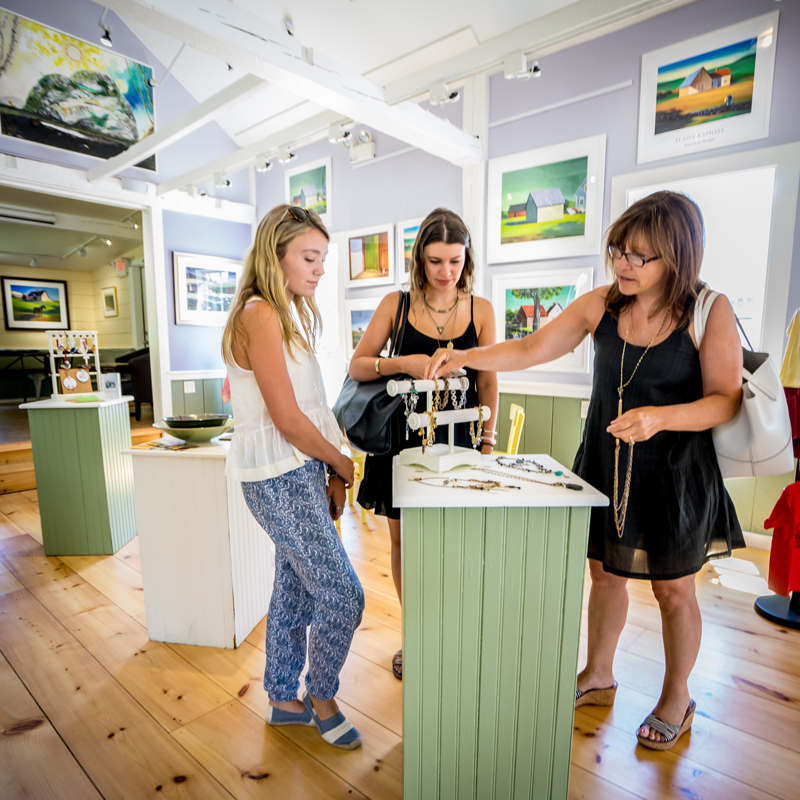
From hand-blown glass sculptures and landscape photographs to figurative sketches and abstract oil paintings, the carefully-curated collections of Southern Vermont’s premier art galleries feature an eclectic array of creative offerings from both local artisan craftspeople and internationally renowned artists. We, at Manchester Life, had the distinct privilege of speaking with the owners of these exceptional galleries about their current collections, the transformative power of art, and the behind-the-scenes work that goes into running an art gallery on a daily basis.
Tilting at Windmills Gallery
24 Highland Avenue, Manchester Center, VT 05255
tilting.com
Owner – Terry Lindsey
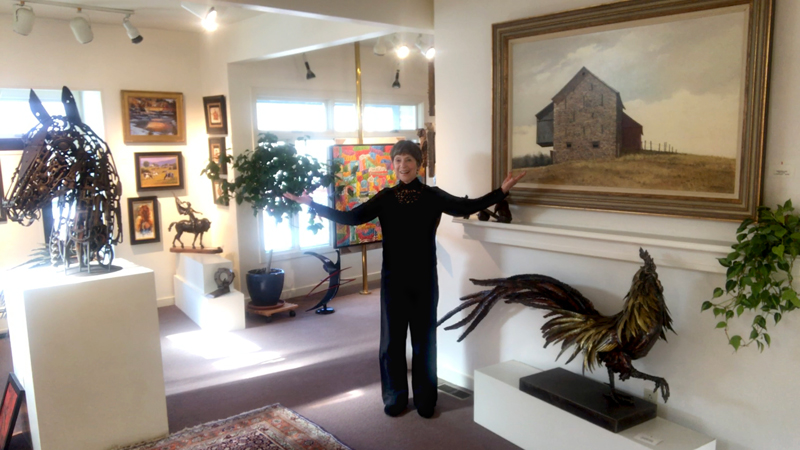
Q: How did you first get involved in the Southern Vermont arts scene?
A: I moved from Middlebury to Dorset over thirty years ago. I met the former owners of the Tilting at Windmills Gallery and ended up working two days a week. I learned about framing and the art business, in general. It was an educational experience that enabled me to create a successful gallery in Saratoga during the summer race season for 15 years. My Equidae Gallery experience enabled me to become the third owner of Tilting at Windmills Gallery, which is presently slated for its 50th anniversary in December 2021! I purchased the gallery about nine years ago, and it has proven to be a rewarding experience. Tilting at Windmills Gallery is acknowledged as one of New England’s best galleries. It has quite an amazing story. It started in 1971 as a poster shop in the center of town and has since evolved into a high-end destination gallery in a new location off of Main Street. When the second owners decided to move to Florida, I became the third owner. I’m actually an artist myself, which has offered me personal insight that typical gallery owners might not have. However, whether you’re an artist or not, the passion for great art is what is most significant.
Q: How would you describe your gallery’s presentation, ambience, and aesthetic?
A: I try to have a very eclectic presentation in Tilting, so I have a wide spectrum of works that people can experience and enjoy. I have three-dimensional, high-end realism pieces from artist/Master, Gunter Korus. Two of the original artists that supported Tilting’s growth and fame, A. Hale Johnson and Gerald Lubeck, are still visible in the gallery. I have a few other local artists, but I feature artworks from artists from all over the world. I like to keep things diverse, and exciting. Whether old or brand spanking new, the thrill of art does not diminish. I hope that visitors feel at home, comfortable, impressed, and inspired.
Q: What goes into running an art gallery on a daily basis?
A: In the past year, there has been a notable increase in my social media promotions, as well as online sales and sales from mailings. Consequently, my computer and I have formed a strong bond. Packing is always a big part of the gallery business, as is shipping, bookkeeping, and keeping track of the finances, which my husband helps with. Due to COVID, I have chosen to remain solo, which has been a bit daunting at times. Keeping up the website and maintaining a presence on all of the online platforms requires a good deal of time invested. Every sale provides impetus to rearrange the gallery and keep a fresh appearance. If you love art, owning a gallery is a wonderful experience. It is stimulating, rewarding and exhausting, like all ventures.
Q: What do you think makes good art?
A: I really feel like the most important quality to think about when you’re looking for a piece of art is whether or not the piece really speaks to you. There are artworks that elicit such a powerful emotional response in us that we can’t get them out of our minds. I’ve seen art that has lingered in my mind for years. This method of choice provides security in the constant daily viewing pleasure for life. That’s what I hope to have happen when somebody comes in to look. The passion of the artist is also incredibly important. If the artist is really working from their heart, their work is going to connect with many – and that is the biggest compliment an artist can receive. My ultimate goal is to help people purchase art that will provide the same thrill every day in their homes!
Helmholz Fine Art Gallery
442 Depot St, Manchester Center, VT 05255
helmholzfineart.com
Owner – Lisa Helmholz-Adams
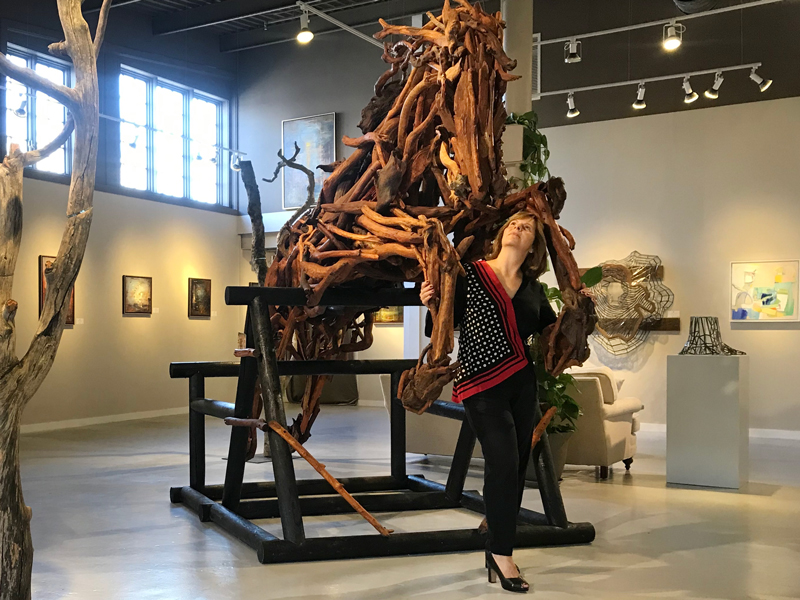
Q: How did you first get involved in the Southern Vermont arts scene?
A: My love of art comes from my parents, and where I was raised: Dakar, Senegal, the furthest tip of West Africa. My father was a director for the World Health Organization. While living in Senegal, he started an impressive collection of African Art. He has donated various African sculptures to the Metropolitan Museum of Art in New York City. I was always with him during his travels. I was part of the buying process and formed strong cultural connections that shaped my worldview at an early age. My parents always took my brothers and I to museums and big art exhibitions from the time that we were children. When I settled here in Vermont 32 years ago, I really got interested in the art gallery world, and I’ve been doing this kind of work ever since. My mother is my Director. She has a Fine Arts degree from Pratt Institute. She has always been an artist and owned her own businesses. Her knowledge of the Arts is incredibly impressive. Everyone always loves seeing her. Her personality is so uplifting. Every time you see her, you will always leave feeling so good and like you have learned so much that you didn’t know before. Before I opened Helmholz Fine Art, I ran another gallery for 20 years, and I formed some wonderful relationships during that time. I went on to open my own gallery with support from my husband and sons. The business is truly a family endeavor. I’ve been here for five years at my current location, and it’s been an incredible experience. The gallery is in an enormous space. I have some very, very large Masterpiece Paintings and beautiful sculptures in my collection, so it’s a perfect place to showcase them.
Q: How would you describe your gallery’s presentation, ambience, and aesthetic?
A: I always hear people say that they love the artists that I represent – especially the way that I curate their work in my gallery. Over 25 years of curating major exhibitions, I have learned so much, and I bring that experience and knowledge to the gallery. Lighting plays a huge part in the presentation. Most people don’t realize the time and effort that it takes to properly position and light all of the works in a gallery, and even more time and attention goes into my preparation for a show. Details, details! I’m not a gallery of 30-50 Artists – I’m a gallery of an impressive 12-15 artists and sculptors, as well as mixed media and high-end photography pieces. My experience has shown me that when I used to represent 30-50 artists – both nationally and internationally – I found that the gallery was not focused. I wanted my own gallery to be more involved with my artists. I wanted to bring all of my experience to help them thrive and grow with total freedom to express themselves. This has made an enormous difference in the kind of experience that you have coming into Helmholz Fine Art. I love talking about my artists. I’m very passionate about them and consider them my extended family. I’m always learning from them. I show artists that have been working in their respective mediums for 10-45 years. Some are featured in museums across America and are national award winners in the arts. They live and breathe art. Even during the pandemic, they continued to create incredible and powerful art!
Q: What goes into running an art gallery on a daily basis?
A: I’m always thinking about the next exhibition. The creative process takes a lot of hard work. Sometimes it takes years to bring my vision for each exhibition to life in my gallery. I have an amazing team that I work with. I’m also all about representing artists here in Vermont. Whenever I have a major exhibition in the works, I spend time in my artists’ studios, and I get to be a part of their creative process when they make their masterpieces. I talk with them and listen to their voice. This enables me to talk with collectors and bridge the connection to the artist in a more meaningful way. My gallery is also all about the community. Giving back means everything to me. I love having local students visit and
experience art. Knowing that I have helped young children expand their imaginations and served as a bridge for new artists makes it all worth it! I have hosted Hunger Free Vermont (HFVT) events – The Feast of Venus – for four years to educate the public and celebrate the community coming together and helping each other. It all started from a masterpiece painting, The Feast of Venus, by my artist Elizabeth Torak. The piece is about a community of women cooking and working together. It inspired me to bring the first HFVT event into existence four years ago. Thanks to the events I hosted, southern Vermont knows more about the really important work of feeding those in need! We are all in this together, and I’m excited to share my love and passion of the arts as I move into the next phase of Helmholz Fine Art!
3 Pears Gallery
41 Church St. Dorset VT, 05251
3pearsgallery.com
Owner – Greg DeLuca
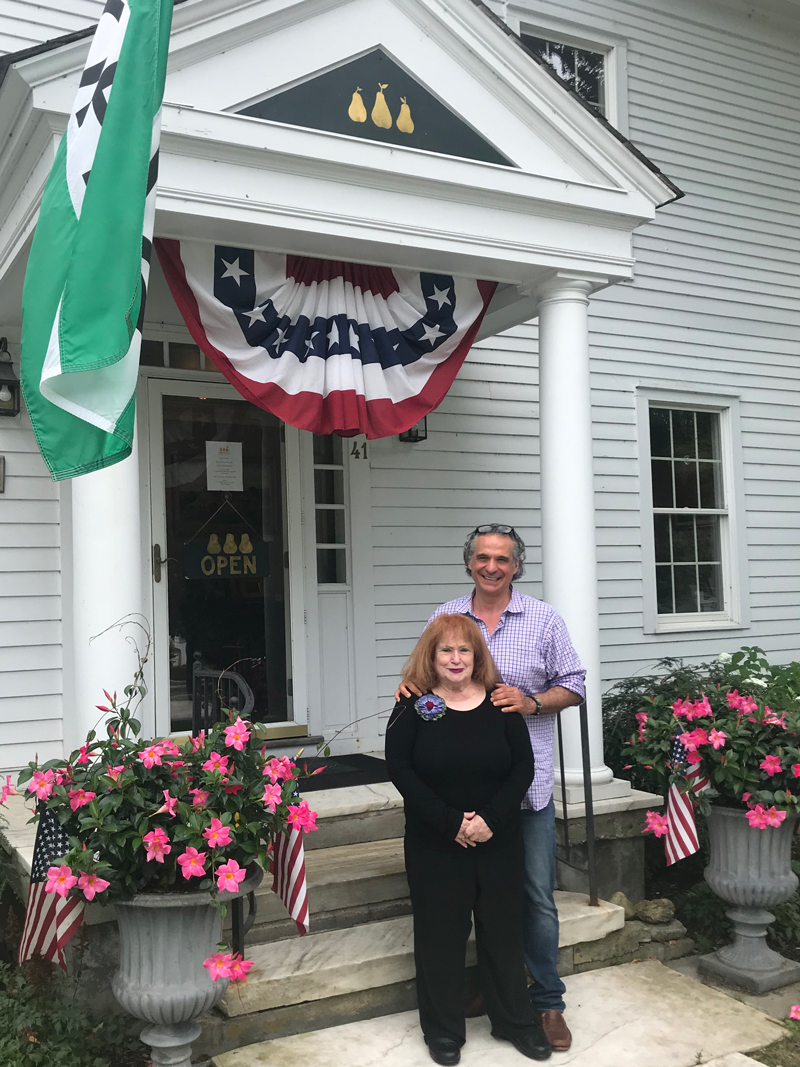
Q: How did you first get involved in the Southern Vermont arts scene?
A: My wife, Judith, and I first opened 3 Pears Gallery eight years ago. It all began with a series of sequential events. First, we did a pop-up gallery in Manchester for Columbus Day weekend that went really well. Then, the following weekend, I opened up a temporary gallery in our barn space in Pawlet on Route 30, which flourished throughout the whole summer. After that, we were looking for a permanent space, and we found one on the Dorset Green. I have a really good relationship with a lot of artists in the area, and I have an extensive background in arts, design, marketing, and agenting. When I first started, I thought that running the gallery would be a wonderful way to combine my past experiences with my love for fine art, my love for artisan pieces, and my love for Vermont.
Q: How would you describe your gallery’s presentation, ambience, and aesthetic?
A: Our gallery is very unique in the sense that we carry both high-end fine art and artisanal pieces. At a lot of other galleries, you will find that it’s usually one or the other, but we have a wonderful and finely-curated mix of works here. Coming into our gallery, you’ll see everything from $40 mugs to $15,000 paintings. Every piece in our gallery – regardless of the price range – has an incredible level of craftsmanship, passion and expertise behind it. The majority of our artists are Vermont artisans. If they’re not from Vermont, they’re from surrounding areas near Vermont. Our gallery is very welcoming and warm. It’s a healing environment. When you bring something into your home from our gallery, whether it’s a piece of art or an artisan piece, it’s like you’re bringing a new family member into your home. It’s joyful, and it’s organic in the sense of bringing the beauty of nature into your home. Vermont is a very seasonal and outdoorsy place, and we reflect that with the way that our gallery changes on a quarterly basis. We have big fall displays, holiday displays, spring, and summer displays. The ambience and décor in the gallery changes with the seasons, as do the art and artisan pieces that we show, and the manner in which they are merchandised. We’re always in a constant state of organic change. It’s not a static gallery at all.
Q: What goes into running an art gallery on a daily basis?
A: Apart from the unglamorous stuff, such as bookkeeping, and typical daily operations, it’s a lot like running a show in a theatre. When you walk in, I’ve created an experience for you to feel. There’s a lot of work that goes into that. There’s the upkeep and the office work, but you also have to go out to artists’ studios, talk with them, see where they are in their process, and see if they have any work that is currently salable that you can use in the gallery. Sometimes an artist will go in a totally different direction, and their work will not be salable at our gallery. You have to understand that artists go through a creative journey and work through it with them, so you can continue to have a prosperous relationship. I find the whole process of working with artists to be really exciting.
Village Green Gallery
661 Main St. Weston, VT 05161
villagegreengallery.com
instagram.com/villagegreengallery
Owners – Annie + Rob Aft
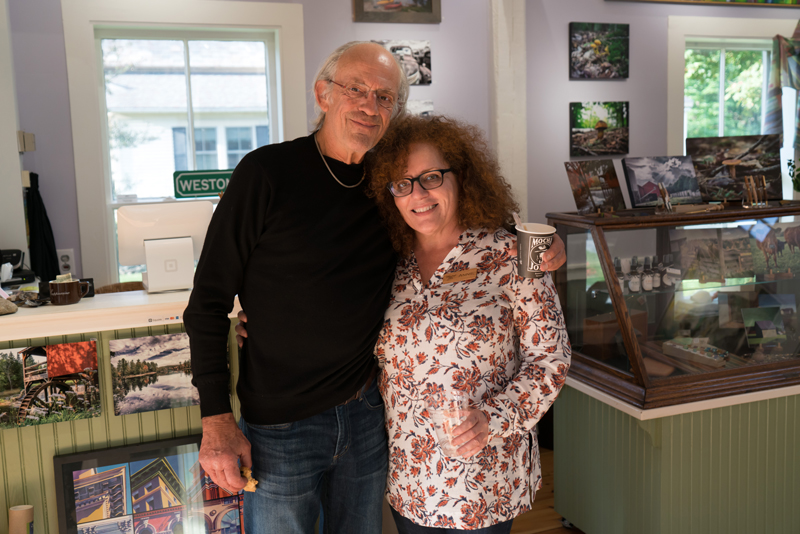
Q: How did you first get involved in the Southern Vermont arts scene?
A: (Annie) – I grew up in Vermont and New York City. My parents, Elaine Raphael and Don Bolognese, were both well-known artists and illustrators. I spent summers in Vermont, as well as most long weekends and school holidays. I also went to school for a few years at Flood Brook in Londonderry. Rob and I currently split our time between Vermont and California. We built a house in Landgrove ten years ago and started spending more time here. A few years later, our friends who had been running the Village Green Gallery in Weston for a decade told us that they were looking for someone to take over operations. At that point, we already knew many Southern Vermont artists and artisans who we had met through my parents, the gallery, and the famous Weston Craft Show. Taking over the gallery was a great way to become more involved in the local community. To this day, we host a lot of community gatherings, play readings, and meetings for local non-profits and the Weston Playhouse. We’re proud to be a community hub here in Weston.”
Q: What goes into running an art gallery on a daily basis?
A: (Rob) – One challenge that we often encounter is that many of the artists and artisans that we work with produce a limited number of pieces. Whether it’s ceramics, glasswork, jewelry or paintings, people tend to think that we have backup stock. A big part of our job is staying in contact with our artists and artisans to secure new pieces. We visit their studios often, so we understand the amount of hard work and time that goes into each piece. Once we went as far as to take a photographer’s work off of the walls of his home, and now that those pieces are sold, we have none of his work available. On the last day of the Weston Craft Show we visit all of our artisans and collect as much of their work as possible for the holiday season.
Q: How would you describe Southern Vermont’s arts scene?
A: (Annie) – It’s a regional scene, but the quality of the pieces is extremely high. I’m always blown away by the level of skill and mastery that the woodworkers, potters, and glassblowers bring to their work. The artists in Vermont are incredibly good at what they do, and I think that their work reflects the personality of the region. I really enjoy telling our customers about the artisans who make the pieces that we sell here at Village Green Gallery. For example, people might not know that the beautiful local spalted woods (maple, birch, oak) must be harvested after the tree dies but before it falls. Our woodworker sources his own materials and can go on for hours about why he uses one wood rather than another. I love to tell the stories behind the pieces— the materials, the artists and all of the skillful work and talent that goes into each one of them.
Ellenbogen Gallery
Old Location (Until Summer 2021):
263 Depot St.
Manchester, VT 05255
New Location (Starting Summer 2021:)
4620 Main St.
Manchester, VT 05255
ellenbogengallery.art
Owners – Carolina Ellenbogen & Michael Ellenbogen
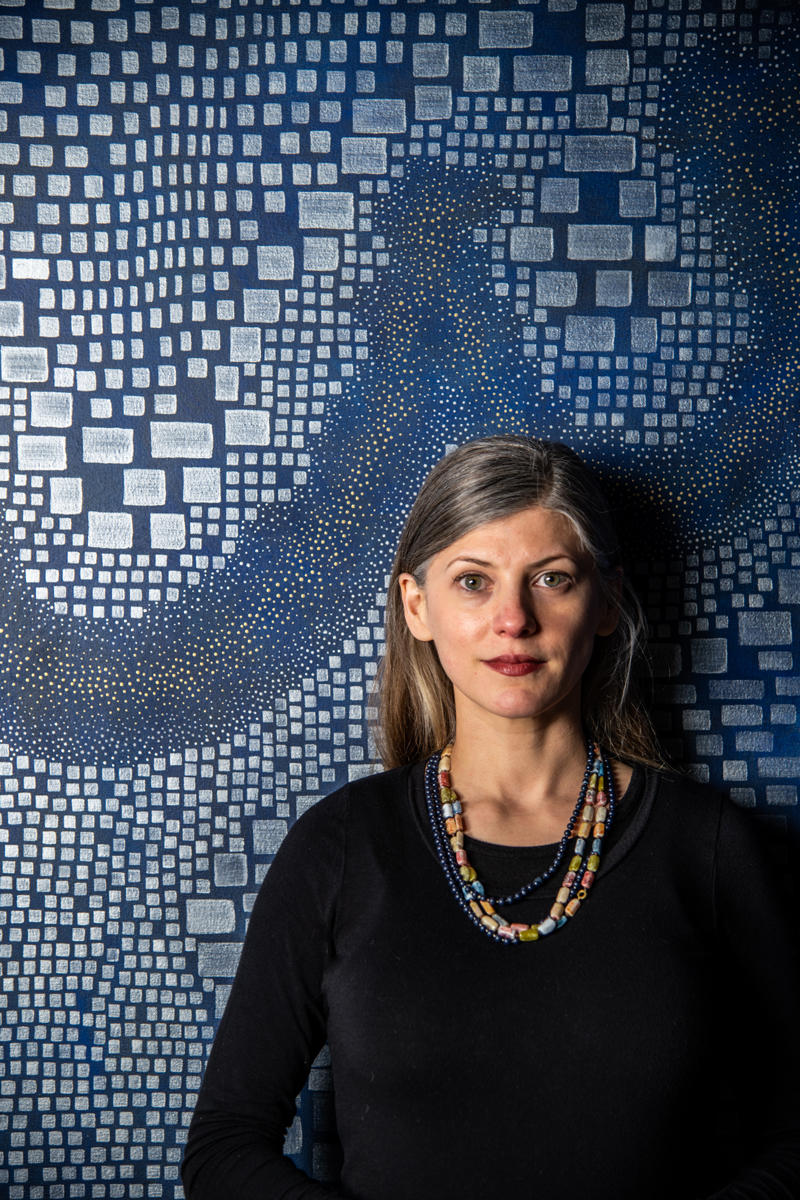
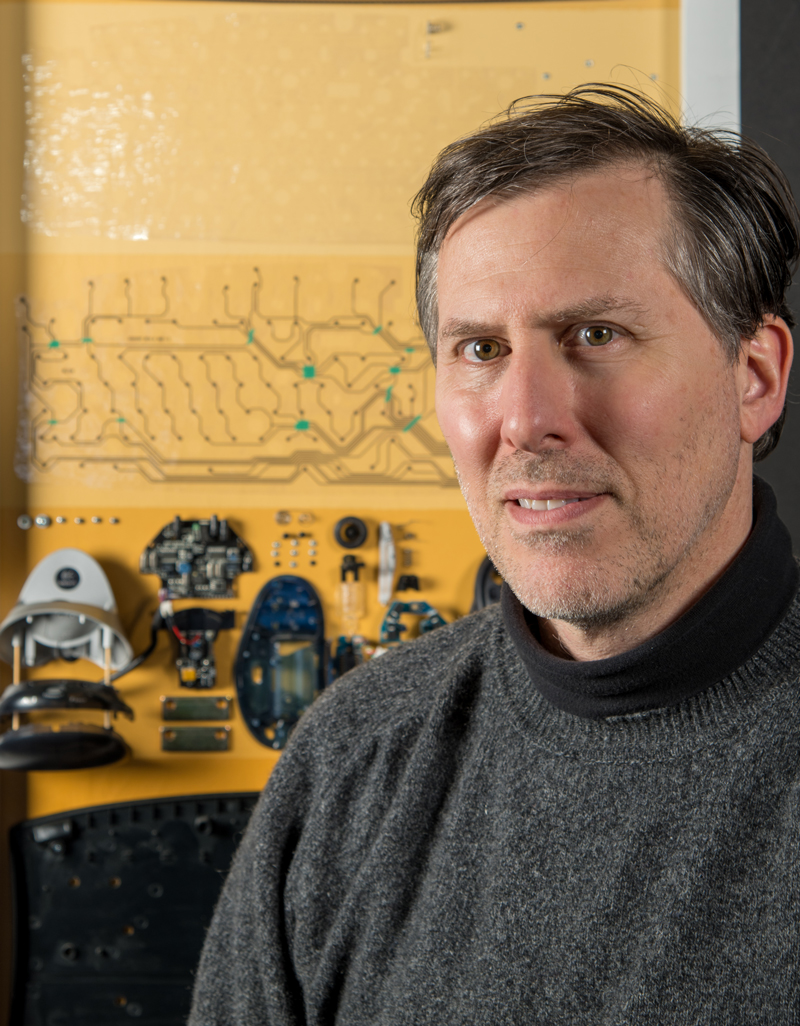
(Carolina) – Michael and I are both artists. He is a very talented photographer – and I’ve been drawing since I was four years old. I started painting and showing my work in my hometown of Maracaibo, Venezuela. I moved here in 2011. Once I moved to Vermont, I started anew as an artist. When you live in a new place, everything around you transforms, so you begin to see things differently. I became inspired to start painting in a more abstract style than I had before. While I was going through my period of artistic rebirth, Michael and I noticed that we couldn’t find too many galleries in the area that would host shows with big groups of artists that were painting in a non-figurative style. That provided us with the inspiration to create this space. We acquired the space on Depot Street in June of 2017 and hosted our first fully curated show in November of 2017. Since that time we have developed strong relationships with many artists including Lynne Averill, Christopher Curtis, Reg Darling, Dublin Durller-Wilson, Barrack Evans, Mary Fran Lloyd, Dona Mara, Dan Mosheim, Alfred Perry, Rodrigo Nava, Harry A. Rich, John Richey, Julian Sheres, Gregory Smith, Longina Smolinski, James Vogler, Marcia Vogler, Michael Watson, Richard D. Weis and Michael L. Williams. After several years in our current space, we are thrilled to have acquired a brand-new location on Main Street. We’ll be moving in there early this summer. It’s going to allow us to showcase our collections in a stylish and compelling manner.
Q: What goes into running an art gallery on a daily basis?
A: (Michael) – There is always a lot of customer outreach. On an average busy day, one of the most important parts of running an art gallery is following up and reconnecting with people who have expressed interest in the art that we are showing. There’s a lot of work that goes into setting up shows, as well. After the artists that we work with have put all of their passion and energy into creating the art, they then bring it into our gallery and hand it over to us. It’s up to us to present it in the most appealing and tasteful way possible. The promotion aspect is also incredibly important. You have to write press releases, do social media posts, and constantly update the website. It’s all part of creating an immersive and memorable experience for the people who come through the door. At the end of the day, we want to make sure that we’re putting our art out in a way that connects and resonates with our customers.
Q: What do you think makes good art?
A: (Michael) – Art is not always entirely about aesthetics. Obviously, the aesthetics will draw you towards a work of art initially. I like a picture of a beautiful sunset as much as I like a Picasso painting, but I think it’s wonderful when you can tell that an artist is entirely committed to their craft – especially when they are effectively able to communicate the stories behind their works. I love artists who can speak eloquently, concisely, and clearly about their art and explain the inspiration behind it. Marcel Duchamp is a great example of that. He was incredibly well spoken, and really shed a lot of light on his creative process and the artistic vision behind his work. Back in the era of Dadaism, there was a lot of controversy surrounding the nature of art, and whether bicycle wheels on stools should be considered real “art.” I personally think that anything that makes an artistic statement and makes you think can be considered great art, but beyond the statement, it has to be backed up with purpose. When the intent behind the execution of an artwork is well-defined, the piece gets elevated to a new level of greatness.
Epoch Artisans Gallery
4927 Main St. Manchester, VT 05255
epochvermont.com
Owner/Member Artist – Nick Seidner
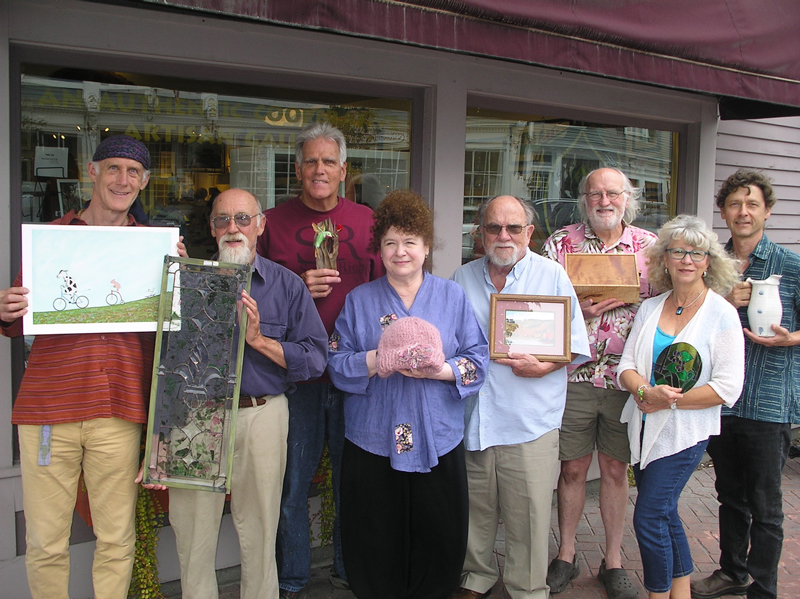
Q: How did you first get involved in the Southern Vermont arts scene?
A: I moved to Vermont in 1997 to help run the pottery program at Frog Hollow in Manchester Village. I taught pottery classes there with Diane Rosenmiller, and we also sold our work in the gallery upstairs. It was a great way for us to get situated in Vermont as working artists. In the fall of 1998, we bought a property in Middletown Springs, and we set up Rising Meadow Pottery. While we were working hard to become established there, we maintained our connection to the Manchester arts community through Frog Hollow. I left Frog Hollow in 2005, and was approached by a group of artists who were setting up an artist’s cooperative gallery in Woodstock, Vermont called Collective – The Art of Craft. When Frog Hollow was in crisis mode in 2008, a group of concerned artists met to discuss how to save that organization. A follow up discussion with Mt Tabor furniture maker, Bob Gasperetti, led to the beginning of something new. We started brainstorming about starting a collective-based gallery in Manchester. From there, we started to pull in talented folks, such as Lynn Adams, who was the treasurer and bookkeeper from Collective – The Art of Craft. She came on board and brought her expertise and experience to help with the financial piece. She really helped to get things going and also helped us to establish the Collective model. Lynn is also a very talented jeweler, who makes incredible pieces with silver and enamel. I’m proud to have played a significant part in the formation of a nonprofit cooperative gallery here in Manchester, and I’m grateful for the significant contributions of all of the talented artists that I work with here.
Q: What goes into running an art gallery on a daily basis?
A: As a nonprofit artist collective gallery, we face fairly unique challenges, but we try to promote and instill a sense of cooperative responsibility among all of our members. We’re all in this together as a group of independent spirits and small business owners who are collaborating with this venture. One of the best things about the collective model is that we can use the greatest strengths of every member artist to accomplish our goals. Not everybody is great at marketing. Not everybody is great at photography, but we all support each other and draw on our skill sets to help out. We work hard to make the day to day operations of the gallery run smoothly. One of my responsibilities is putting out the monthly staffing calendar. Making sure that someone shows up to open the doors is probably the greatest worry.
Besides that, we work as a team to make sure that the gallery looks great and we have everything in place to make sales. The challenges are seemingly infinite, but we are able to manage all of them and grow stronger by working together.
Q: How would you describe the Southern Vermont arts scene?
A: Southern Vermont has an incredibly vibrant artistic community. There are so many talented artists and craftspeople that work in the area – many of whom are part of the membership here at Epoch Artisans Gallery. Artists are incredibly passionate about their work here in Vermont, but they’re also very humble and unpretentious with a serious independent streak. I think that kind of attitude is ingrained in the local culture. There’s also a phenomenal level of diversity and creativity in terms of the mediums and styles of disciplines that people work with here. Members of our co-op include glassworkers, woodworkers, sculptors, furniture makers, potters, photographers, metalsmiths, painters, jewelers, and fabric artists. Each artist imbues their work with their love, passion and personal character, helping to define the gallery vibe.
Additional Local Gallery Exhibitions
Equinox Village
49 Maple Street
Manchester Center, VT 05255
(802)-362-4061 equinoxvillage.com
The Canfield Gallery
Martha Canfield Library
528 East Arlington Road
Arlington, VT 05250
(802)-375-6153 [email protected]
The Dorset Village Public Library
3331 VT-30
Dorset, VT 05251
(802)867-5774 dorsetvillagelibrary.org
Long Ago & Far Away
4963 Main Street,
Manchester, VT 05255
(802)362-3435 longagoandfaraway.com